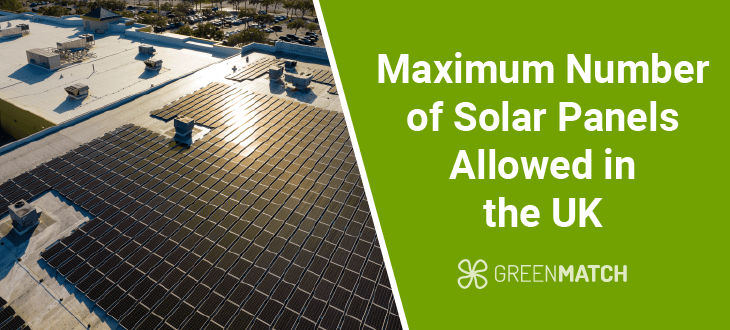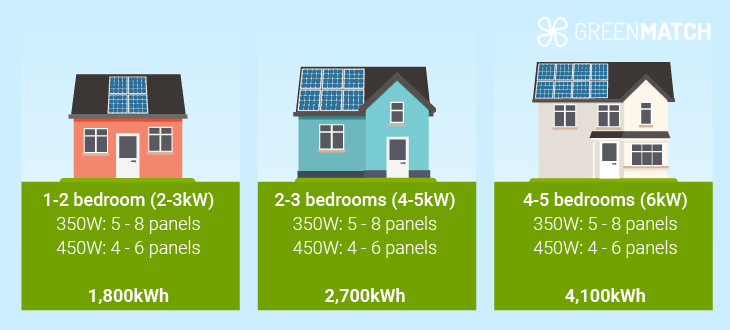Answer these simple questions and we will find you the BEST prices
Which type of solar quotes do you need?
It only takes 30 seconds
100% free with no obligation

Get up to 4 quotes by filling in only 1 quick form

Slash your energy bills by installing solar panels

For the average 2-3 bedroom house
- GreenMatch
- Solar Energy
- Solar Panels
- Maximum number of solar panels allowed in the UK
What's the Maximum Number of Solar Panels Allowed in the UK?


- While there is no maximum number of panels you are allowed to install, installations above 3.68kW (typically 8 - 11 panels) require prior approval.
- There is no legal limit to the amount of solar energy you can generate. However, earnings through the Smart Export Guarantee do not apply to solar systems larger than 5MW.
- Regional rules, especially those in listed buildings or flats, can limit the number of solar panels.
With solar panels, it’s usually a case of “the more, the merrier” since there is no maximum amount as long as you have permission. However, physical limitations, certain legal regulations, and best practices can limit the maximum number of solar panels you can install. Let’s go over what you need to consider before deciding how many solar panels you need.
That said, we can only advise you with estimates. The best way to gauge how many panels you can install and get accurate solar panel cost figures is to contact an installer. A reliable installer can be hard to find, requiring hours of research and calling up companies. Our service simplifies the process down to a 30-second form and provides you with up to 4 free, non-binding quotes.
Click the button below to receive prices from installers we’ve personally vetted.
- Quotes from local engineers
- Payment by finance available
- Save up to £1,567 per year
It only takes 30 seconds



How many solar panels can you have in the UK?
There is no maximum number of solar panels you are allowed to install. However, installations above 3.68kW will require permission from the local Distribution Network Operator (DNO). For larger systems, you need a G99 application. Aside from that, the max number of solar panels allowed in the UK is limited primarily by the space you have or regional specifics.
For smaller systems, you won’t need planning permission to install solar panels, unless they are on a dwelling and or are visible from a road. There are certain types of properties that are more likely to require planning permission. These include:
- Listed Buildings
- Flats
- Properties in Conservation Areas
In November 2023, the UK government eased planning permission requirements in conservation areas. As of the new rules, homes with flat roofs no longer require planning permission, which can reduce delays and installation costs.
If you’re wondering, “how many solar panels can I have on my roof?”, that’s a different question. Solar panel sizes are generally measured in kilowatts (kW), with each kW unit being roughly 2m2. Here is the average size of solar panel systems in the UK.
| Solar system size | Number of panels (350W to 450W) | Required roof space (2m2 panels) |
|---|---|---|
| 1kW | 2 - 3 | 4m2 - 6m2 |
| 2kW | 4 - 6 | 10m2 - 8m2 |
| 3kW | 6 - 8 | 12m2 - 16m2 |
| 4kW | 8 - 10 | 16m2 - 20m2 |
| 5kW | 10 - 12 | 20m2 - 26m2 |
| 6kW | 13 - 15 | 26m2 - 32m2 |
| 10kW | 20 - 26 | 40m2 - 52m2 |
| 12kW | 26 - 30 | 52m2 - 64m2 |
Generally, a 3 bedroom home will have 70m2 to 75m2 but not all of it will be usable space. Roof sizes can vary and many roofs can have physical disruptions that make it difficult to gauge how many panels it would need.
Moreover, the best roof angle and direction for solar panels is a southward-facing roof with a 30° to 40° incline, so there is a chance that only part of your roof will be worth outfitting with solar panels. This can leave you with limited space since north-facing directions may not provide a significant return on investment, although there’s no rule stopping you from installing it.
In total, the average home has enough space for 20 solar panels. Since solar panels are about 2m2, quite a lot of them can be installed on a roof. Assuming you have 20m2 of viable roof space, you could fit a 4kW system on the average 3-bedroom home.
Is there a maximum amount of solar energy you can produce?
There is no maximum legal limit on how much energy you can produce with solar panels. As long as you have a big enough inverter, your solar panels should be able to capture as much sunlight as you want. As long as your system doesn’t exceed 5MW (megawatts), you can even continue to earn money by exporting energy to the grid.
Of course, every solar panel has physical limitations on the amount of energy it can produce, indicated by the rated capacity, which is about 1kW per metre square. In reality, many factors prevent solar panels from achieving this precisely. Over the course of their 25-year lifespan, each kW worth of solar panels will generate roughly 20,000kWh of electricity in the UK.
Your phase connection may also limit the size of the system you can opt for. Most networks allow system sizes based on their phase connection. The maximum solar energy on a single phase in the UK (which applies to the majority of homes) is up to the electricity output limit 3.68kW (per phase). Other larger homes and businesses run on a 3-phase connection with up to 11kW. Any larger wattage will require DNO permission.
Check with your network to see whether they have a pre-approval scheme. The requirements for approval include system size/capacity, which can vary based on your network. The connection could be automatically approved in most cases as long as these criteria are met.
It’s also worth noting that network size limits may not necessarily be set in stone. You could still get a larger solar panel system with a single-phase inverter. However, this may require more bureaucracy and lead to longer wait times and additional charges.
Can you have two separate solar systems in the UK?
Yes, you can install multiple solar panel systems as long as you have permission from the DNO and the second system doesn’t interfere with metre readings and SEG export amounts. This can have some benefits, as your home setup may not be suitable for one large solar panel system, requiring you to divide it.
Running two systems can be tricky since it may require twice the equipment in certain respects. You’ll have to deal with 2 solar panels, multiple sets of monitoring apps, and multiple warranties. Another thing worth considering is that you will have to pay for two different installations and, if applicable, separate removal fees for your panels.
Pros and cons of large solar systems
- Bulk discount
- High energy output
- Higher SEG earnings
- High initial cost
- Require more space
- More maintenance
Pros:
- Bulk discount: Larger systems will have higher discounts. On top of that, the current 0% VAT scheme and similar solar panel grants make it a great time to buy a larger setup.
- High energy output: The more kWs a system can support, the more it will generate. This can power larger homes or even serve as a charging station for multiple vehicles.
- Higher SEG earnings: With a higher output, you can also make more money by exporting energy to the grid.
Cons:
- High initial cost: There’s no denying that the initial cost will be high, even with the savings on a large system.
- Require more space: The physical dimensions of these systems can be demanding, especially for roof-based systems.
- More maintenance: Cleaning solar panels is not that difficult, but it is necessary. With a larger solar panel system, you will need to remove dust, excessive snow, or bird droppings off a lot of panels.
How many solar panels should you have?
The number of solar panels you should have depends on what you want to use them for. If you’re looking to cover electricity needs for an average-sized household, you won’t need more than 10 panels. However, if you are aiming to earn money by exporting energy back to the grid, you will want to exceed your energy consumption.
If you’ve ever wondered “How many solar panels do I need to cover my home’s energy needs?”, you will need to determine your annual energy consumption first. Here’s a handy image with multiple house sizes.

Out of the most common sizes, 4kW solar panel systems with 8 to 10 panels can cover most energy needs for the average home. Since most homes require 2,700kWh per month in energy generation, a bigger system may be unnecessary. A 6kW solar system can be sufficient for most larger homes.
| System size | Space required | Number of panels (350W to 450W) | Annual energy output | System cost |
|---|---|---|---|---|
| 3kW | 12m2 - 16m2 | 6 - 8 | 2,550kWh | £5,700 - £7,000 |
| 4kW | 16m2 - 20m2 | 8 - 10 | 3,400kWh | £6,600 - £8,100 |
| 5kW | 20m2 - 26m2 | 10 - 12 | 4,250kWh | £8,300 - £10,200 |
| 6kW | 26m2 - 32m2 | 13 - 15 | 5,100kWh | £10,000 - £12,200 |
| 10kW | 40m2 - 52m2 | 20 - 26 | 8,500kWh | £12,300 - £15,000 |
| 12kW | 52m2 - 64m2 | 26 - 30 | 10,200kWh | £14,700 - £18,000 |
Commercial solar panels can be even larger, starting at 10kW solar system setups and going up to 100kW systems. These will be more appropriate for businesses and large buildings with higher energy demand.
If you want to learn more about what size solar panels are most suitable for your home, you should consult a professional installer. There are many factors to consider so it can be difficult to know without a proper assessment.
However, you should be sure that you’re hiring a reliable installer, which can take up hours of your time. If that sounds tedious and time consuming, you can instead try our service. We have an extensive network of solar panel installers that we’ve vetted ourselves.
Click the button below to receive up to 4 free quotes with no payment obligation.
- Quotes from local engineers
- Payment by finance available
- Save up to £1,567 per year
It only takes 30 seconds



FAQ
There is no legal limit on how many solar panels you can install in most areas of the UK. However, systems above 3.68kW will require permission, and certain areas may have regional rules.
It is fully acceptable to install a 10kW solar system as long as you have adequate space and have permission for the appropriately sized inverter.
No. There is no legal limit on solar panels in most areas. However, it’s important to weigh the pros and cons of large solar systems.

Rawal Ahmed is a writer at GreenMatch with an interest in sustainability and a background in tech journalism and digital marketing.
We strive to connect our customers with the right product and supplier. Would you like to be part of GreenMatch?

